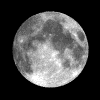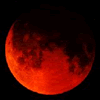 A
lunar eclipse occurs when the Earth passes between the Moon and Sun, aligning
the three celestial bodies and casting its shadow over the surface of
the Moon. Thus, lunar eclipses always occur at full Moon - but not all
full moons. Because the orbit of the Moon around the Earth is slightly
out of alignment with that of the orbit of the Earth around the Sun, not
every full Moon creates a lunar eclipse. It is only when the two orbits
coincide that a lunar eclipse occurs. The correct alignment of the three
celestial bodies occurs roughly every six months, thus lunar eclipses
can be expected, on average, twice a year.
A
lunar eclipse occurs when the Earth passes between the Moon and Sun, aligning
the three celestial bodies and casting its shadow over the surface of
the Moon. Thus, lunar eclipses always occur at full Moon - but not all
full moons. Because the orbit of the Moon around the Earth is slightly
out of alignment with that of the orbit of the Earth around the Sun, not
every full Moon creates a lunar eclipse. It is only when the two orbits
coincide that a lunar eclipse occurs. The correct alignment of the three
celestial bodies occurs roughly every six months, thus lunar eclipses
can be expected, on average, twice a year.
Unlike solar eclipses, which can usually only be viewed on a very limited part of the Earth's surface, lunar eclipses can be seen by all people on the night side of the Earth when the eclipse occurs.
 |
Totality
Although less spectacular than solar eclipses, lunar eclipses last longer,
with a gradual darkening of the Moon and totality taking a few hours to
occur. The first part of a lunar eclipse occurs when the Moon starts to
pass through the Earth's partial shadow, the penumbra. This causes a slight
darkening of the Moon which is hardly noticeable to the eye.
 An
eclipse properly starts when the Moon enters the umbra, or full shadow,
and the Earth's shadow can be seen crossing the Moon's surface. The transition
to totality takes about an hour, at which time the whole disc of the Moon
is within the umbra. However, even then the Moon is not completely darkened,
as some light passes through the Earth's atmosphere onto the Moon. This
light has a reddish-orange colour, because more red light than blue light
passes through the Earth's atmosphere. A totally eclipsed Moon therefore
appears as a reddish-orange disc in our night sky.
An
eclipse properly starts when the Moon enters the umbra, or full shadow,
and the Earth's shadow can be seen crossing the Moon's surface. The transition
to totality takes about an hour, at which time the whole disc of the Moon
is within the umbra. However, even then the Moon is not completely darkened,
as some light passes through the Earth's atmosphere onto the Moon. This
light has a reddish-orange colour, because more red light than blue light
passes through the Earth's atmosphere. A totally eclipsed Moon therefore
appears as a reddish-orange disc in our night sky.
Totality can last up to one and three-quarter hours if the Moon passes through the centre of the umbra. If the Moon only passes through the edge of the umbra, a partial lunar eclipse occurs.

|
Lunar eclipse |
Viewing a lunar eclipse
 Viewing
a lunar eclipse is quite safe, as you are looking only at the reflected
light from the Moon and this is no brighter than a normal full moon.
Viewing
a lunar eclipse is quite safe, as you are looking only at the reflected
light from the Moon and this is no brighter than a normal full moon.
Remember, however, the direct viewing a solar eclipse is not safe, as looking directly at the Sun, whether by naked eye, through a telescope, binoculars, sunglasses or tinted glass can cause permanent damage to the eye.
The old adage - "Never look directly at the Sun " is true at all times!
Lunar eclipses can be safely observed by naked eye, binoculars or telescopes. Using a telescope, you can even watch as the Earth's shadow crosses the mountains and craters of the Moon.
| Copyright owned by the State of Victoria (Department of Education and Early Childhood Development). Used with Permission. |
|
|||||||||||||||||||||||||||||||||||||||||||||||||||||||||||||||||||||||||||||||||||||